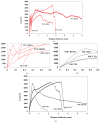Flexural Response Comparison of Nylon-Based 3D-Printed Glass Fiber Composites and Epoxy-Based Conventional Glass Fiber Composites in Cementitious and Polymer Concretes
- PMID: 39861290
- PMCID: PMC11769053
- DOI: 10.3390/polym17020218
Flexural Response Comparison of Nylon-Based 3D-Printed Glass Fiber Composites and Epoxy-Based Conventional Glass Fiber Composites in Cementitious and Polymer Concretes
Abstract
With 3D printing technology, fiber-reinforced polymer composites can be printed with radical shapes and properties, resulting in varied mechanical performances. Their high strength, light weight, and corrosion resistance are already advantages that make them viable for physical civil infrastructure. It is important to understand these composites' behavior when used in concrete, as their association can impact debonding failures and overall structural performance. In this study, the flexural behavior of two designs for 3D-printed glass fiber composites is investigated in both Portland cement concrete and polymer concrete and compared to conventional fiber-reinforced polymer composites manufactured using a wet layup method. Thermogravimetric analysis, volume fraction calculations, and tensile tests were performed to characterize the properties of the fiber-reinforced polymer composites. Flexural testing was conducted by a three-point bending setup, and post-failure analysis was performed using microscopic images. Compared to concretes with no FRP reinforcement, the incorporation of 3D-printed glass-fiber-reinforced polymer composites in cementitious concrete showed a 16.8% increase in load-carrying capacity, and incorporation in polymer concrete showed a 90% increase in flexural capacity. In addition, this study also provides key insights into the capabilities of polymer concrete to penetrate layers of at least 90 microns in 3D-printed composites, providing fiber bridging capabilities and better engagement resulting in improved bond strength that is reflected in mechanical performance. The polymer material has a much lower viscosity of 8 cps compared to the 40 cps viscosity of the cement slurry. This lower viscosity results in improved penetration, increasing contact surface area, with the reinforcement consequently improving bond strength. Overall, this work demonstrates that 3D-printed fiber-reinforced polymer composites are suitable for construction and may lead to the development of advanced concrete-based reinforced composites that can be 3D-printed with tailored mechanical properties and performance.
Keywords: 3D printed; fiber-reinforced polymer; flexure; glass fiber; methyl methacrylate; polymer concrete.
Conflict of interest statement
The authors declare no conflicts of interest.
Figures












References
-
- Agarwal K., Kuchipudi S.K., Girard B., Houser M. Mechanical properties of fiber reinforced polymer composites: A comparative study of conventional and additive manufacturing methods. J. Compos. Mater. 2018;52:3173–3181. doi: 10.1177/0021998318762297. - DOI
-
- Bai J. Advanced Fibre-Reinforced Polymer (FRP) Composites for Structural Applications. Elsevier; Amsterdam, The Netherlands: 2013.
-
- Bank L.C. Composites for Construction: Structural Design with FRP Materials. John Wiley & Sons; Hoboken, NJ, USA: 2006.
-
- Chennareddy R., Tuwair H., Kandil U.F., ElGawady M., Taha M.R. UV-resistant GFRP composite using carbon nanotubes. Constr. Build. Mater. 2019;220:679–689. doi: 10.1016/j.conbuildmat.2019.05.167. - DOI
-
- Lau D. 8—Hybrid fiber-reinforced polymer (FRP) composites for structural applications. In: Uddin N., editor. Developments in Fiber-Reinforced Polymer (FRP) Composites for Civil Engineering. Woodhead Publishing; Cambridge, UK: 2013. pp. 205–225.
Grants and funding
LinkOut - more resources
Full Text Sources
Miscellaneous

